This one is recognizable as a Dodge Omni 024 or a Plymouth Horizon TC3, but it’s actually a 1980 Jet Electrica 007! Dang, that’s a cool name, at least until most people find out that it’s a battery-powered conversion car. That’s when the fun either starts or stops, depending on which side of the fence a person is on, and for those who don’t like EVs, there is no crossing over that fence. This one is on Craigslist in Millersville, Maryland, for $4,000.
Jet Industries, out of Austin, Texas, made several models of vehicles into battery-powered rides back in the 1970s and early-80s in response to fuel shortages. But, as it always goes, once gas prices came down, these cars weren’t popular anymore because cheap gas is what the vast majority of people want to power their vehicles with.
In addition to the Dodge Omni 024 conversions, Jet Industries also made EVs from the Plymouth TC3, Subaru ElectraVans, the Ford Escort, and Mercury Lynx, etc. I’ve read reports of anywhere from 19 to 500 of the Dodge Omni 024 models coming out of the Austin factory, so in any case, this is a rare car. Believe it or not, #1) Vintage EVs are becoming collectible, and believe it or not, #2) We know that not everyone likes battery-powered vehicles! But, for those who do, this will be an interesting vehicle.
The range of EVs is what kills the deal for most people; they somehow expect there to be an instant charging station at regular intervals, just like gas stations are now. As if somehow gas stations suddenly appeared across the globe all at once instead of evolving over 100+ years. This car has a range of 20 miles on its 4-year-old batteries, but with new batteries, it should have a 60-70-mile range. That’s a reasonable distance for daily use for a lot of people. And, since this also always comes up, this car, or any 1980 car, isn’t as safe as a new car would be, as witnessed by this YouTube crash test video of a 1980 Jet Electrica 007. The interior looks fairly good, other than the carpets, and for $130 and a weekend, you’re in business.
The 20 six-volt batteries will weigh around 1,200 pounds or so, but of course, there is no engine, so that offsets it by a few hundred pounds. Still, this car isn’t for sporty handling; it’s for driving 15-20 miles to work or for errands, and then driving home again and recharging. It could be the perfect commuter for a lot of courageous, creative people. You can see lots of surface rust on this car, and I’d be worried about the structural components with the weight of those batteries. And, then there’s the cost of 20 batteries at around $100 a piece, ouch. Not to mention, charging them isn’t cost-free or pollution-free unless a person uses solar panels and isn’t in a hurry to recharge. Like a lawn tractor, this vehicle obviously isn’t meant for everyone, but there are a lot of people who are interested in this technology and the history of these conversion companies.
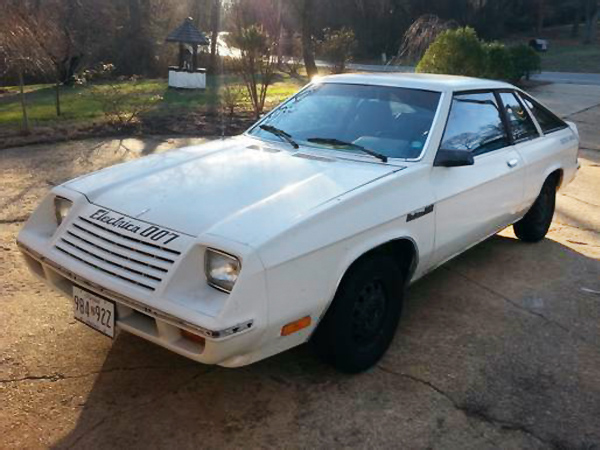
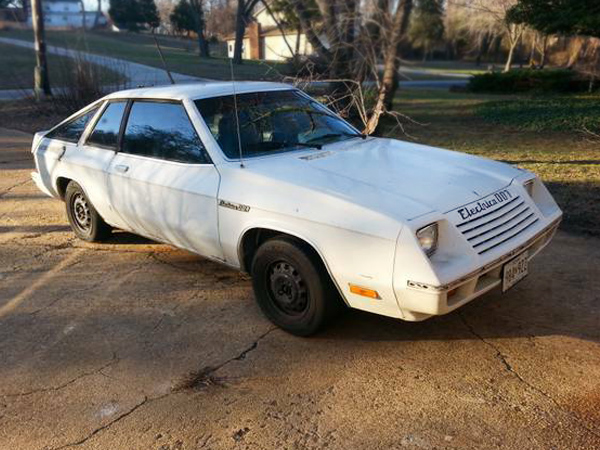
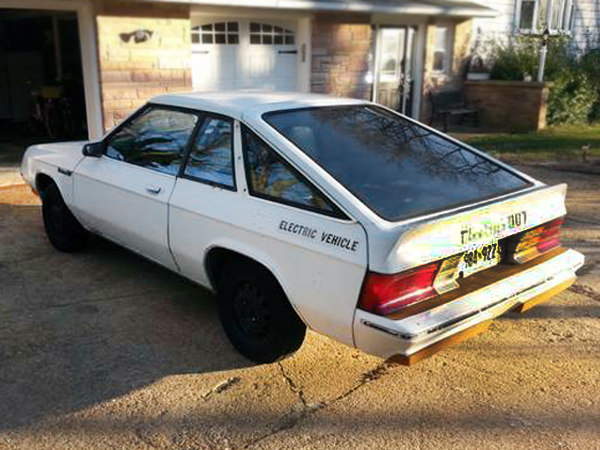
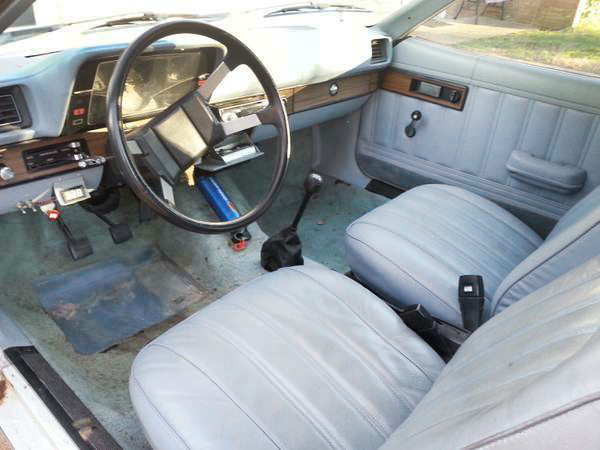
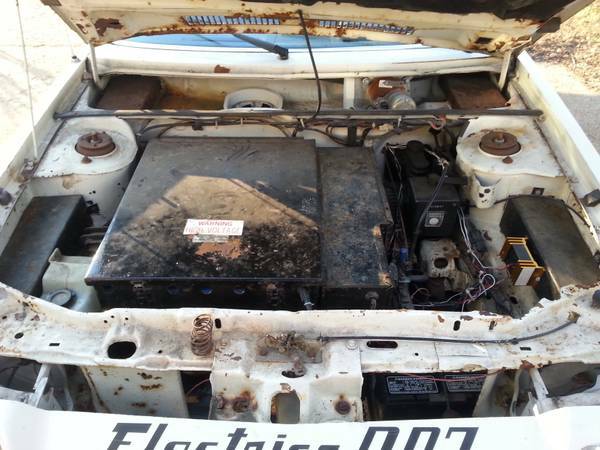

I’m sorry, most proponents of electric cars, I feel, usually have some kind of monetary interest in electric cars, I just don’t see it happening. It’s as if, and maybe this is too intense for Monday morning, but the oil companies must be keeping this development at bay, because, conventional battery/electrics just aren’t viable. Do you realize what kind of back up there would be at charging stations? You couldn’t make enough, and it takes too long. ( maybe a “battery swap” might work, like a forklift) Still, there are just TOO MANY individual cars, and gasoline solves that issue of individual travel. Sorry, I don’t want to be driving a vehicle with 20 acid filled batteries. Until some other method of propulsion is invented ( or we run out of oil) it’s going to be, “fill ‘er up with regular” for a long time. I do believe mass transit is the next big thing. We’re the only (civilzed) country that doesn’t have one.
An electric car like this is so inherently inefficient. You are lugging 1200 pounds around with you to provide the amount of energy that can be had from 20 or 30 pounds of gasoline. And where does the energy for those batteries come from – giant wind turbines which murder countless birds every year, or a power plant burning coal? The great urge to shift the emissions or drawbacks away from one’s own tailpipe does not mean one is driving with no harm to the environment.
One of these races in the 24 Hours of LeMons series, at least at the ones at Carolina Motorsports Park. The Duff Beer guys have it so it will run about 70 mph now (revised batteries) but the range isn’t much–they swap out sets of batteries to keep the car running for a while. They won the Index of Effluency (highest LeMons award) last weekend at CMP…
In 1980 my Dad bought a new Omni O24, white, tan vinyl, 4sp, plus the gold double pin stripe and the all-important ducktail spoiler. I learned to drive on that car. I even learned how to heel-and-toe, which is not a reference to racing but rather the need to keep a toe on the gas to keep it from stalling. Car was decent looking and pretty practical, but rusted quickly and that VW engine was not a good testament to German engineering.
No Thanks.
The “only” way an electric car can be viable, imho, is if the hood, roof, and rear deck were covered in solar cells to keep the batteries topped off, and to assist in the running during the day…
Otherwise, they are all limited by one major thing – RANGE!!!
This is a cool find. Amazing this survived.
This car could be updated with modern electronic components and lithium batteries allowing it to have a 80 to 120 mile range or even more depending how you went about it.
4000 though is nuts. 2000 I could see, but I would not pay more than a grand.
Hydrogen seems like the best alternative to gas powered vehicles (although I would sorely miss the roar and burble of a big honkin’ V8). It just seems that the refueling options are like gasoline which makes it easier to adopt. Thoughts on why it hasn’t caught on? I know, I know, we don’t have the infrastructure, but one would be built quickly when demand is required.
Electricity, while everywhere, really has issues as an infrastructure when you consider some states can’t generate enough power for the homes and businesses now, much less when we add millions of cars.
I do the seller good luck with th sale, and interesting car.
I am sorry but is driving me crazy this is refereed to as a Omni 024. Based on the grill, taillights, and side glass treatment it started as a TC3. I know it is petty but obviously since I can tell the difference I have no life (or am wasting time at work looking at your site).